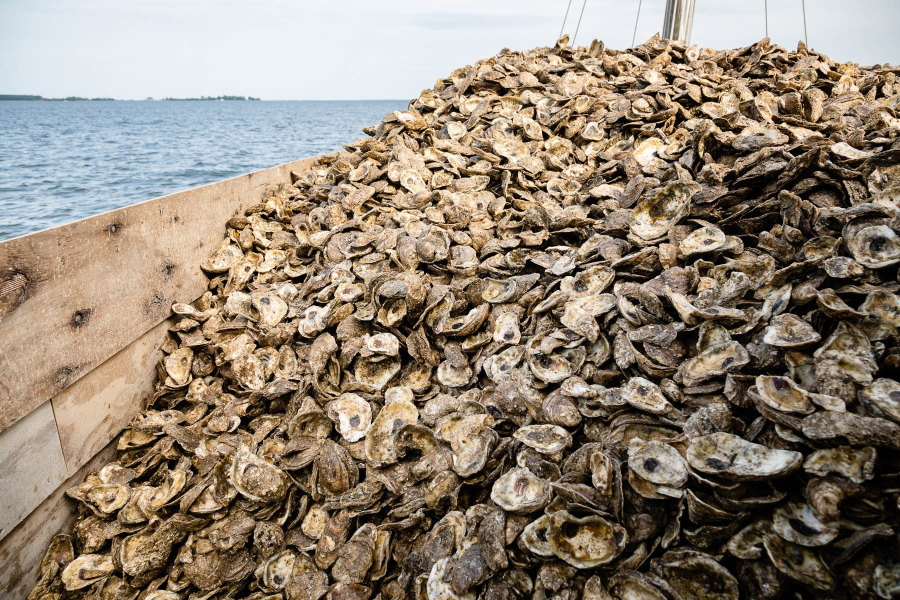Eight out of 10 reefs are now restored in Chesapeake Bay tributaries
Over 1,500 acres of oysters have been planted in Maryland and Virginia over the past 10 years

Chesapeake Bay Program partners have completed eight out of 10 large-scale oyster reef restoration projects. In April 2024, the lower York River in Virginia was celebrated as the most recent site to be finished. The National Oceanic and Atmospheric Administration (NOAA) and the Virginia Marine Resources Commission (VMRC) were responsible for conducting the restoration project, of which over 200 acres of reef were constructed. VMRC Commissioner Jamie Green proudly noted that “this milestone not only fortifies Virginia’s vital commercial fishery, but also sets a national standard for coastal conservation.”
But there’s more to celebrate than just the lower York River being completed. Since 2014, seven out of 10 large-scale oyster reef restoration sites are now in the monitoring and evaluation phase. Another site, Harris Creek in Maryland, is officially completed, having finished its three and six-year monitoring phases with 98% of its reefs meeting the minimum threshold for oyster density and biomass. The Commonwealth of Virginia even added an 11th bonus tributary to their oyster restoration goal in 2019, the Eastern Branch of the Elizabeth River. And overall, oyster restoration in the Chesapeake Bay has not only become an internationally-recognized success story–it is officially the largest oyster restoration project in the entire world.
The Oyster Outcome is on its way to meet its 2025 goal in the Chesapeake Bay Watershed Agreement of restoring native oyster habitat and populations in 10 tributaries. The most recent Chesapeake Bay Oyster Restoration Update notes that at the end of 2023, 1,572 acres of oyster reefs had been constructed across the Chesapeake Bay, which is equal to about 2,075 football fields. Only the Manokin River in Maryland and the Lynnhaven River in Virginia still have reef construction to go, at 222 and 38 acres, respectively.
When sites are selected for large-scale oyster reef construction projects, they go through several phases before they are considered to be complete. First, partners will draft a tributary restoration plan that determines the specific locations as to where the reef will be constructed, how it will be built, the costs in doing so and future monitoring plans. Then construction and seeding of the reef then takes place, followed by monitoring at three and six-year intervals to ensure the reef is working as intended. For the majority of the reefs that have been constructed, the monitoring and evaluation phase will go beyond 2025.
Oysters are incredible little creatures. They are natural filter-feeders that trap nitrogen, phosphorus, sediments and other chemical contaminants when Bay water passes through their gills. When they build reefs, they provide food and habitat for a variety of Chesapeake plant and animal species. And since the 19th century, they have contributed millions of dollars and thousands of jobs to the region.
It’s up to us all to help keep our oyster populations safe. In the past, overharvesting and disease decimated the Bay’s oyster population. But more recently, oysters are threatened by excess nitrogen, phosphors and sediment flowing into the Bay through sources such as agricultural and stormwater runoff. When there is too much nitrogen and phosphorus in the water, the pollutants can cause algal blooms to rapidly grow and die off, removing oxygen from the water around it faster than it can replenish–otherwise known as a dead zone. A lack of oxygen stunts the development of oyster larvae and poor water quality can cause diseases to impact the oysters. Too much sediment in the water can suffocate the oysters. There are several actions you can take to help ensure pollution isn’t running off into your local waterway and entering the Chesapeake Bay–like cutting back on your pesticide use. If you catch oysters yourself, or simply like to eat them, consider recycling their shells to be made into new reefs.
Many other partners besides NOAA and VRMC are actively engaged in restoring oyster reefs throughout the Chesapeake Bay. They include the Maryland Department of Natural Resources, Oyster Recovery Partnership, Potomac River Fisheries Commission and several other non-profit organizations, academic institutions and local governments.
“It’s exciting to see the progress that has been made toward the goal to restore oyster reef habitat in 10 Chesapeake tributaries by 2025,” Kevin Schabow, acting director of NOAA’s Chesapeake Bay Office, says proudly. “All this work is possible thanks to the strong partnership of federal and state agencies, local governments, nonprofit organizations and academic institutions who are committed to restoring the tremendous ecosystem and economic benefits that healthy oyster reefs provide.”

Comments
There are no comments.
Thank you!
Your comment has been received. Before it can be published, the comment will be reviewed by our team to ensure it adheres with our rules of engagement.
Back to recent stories